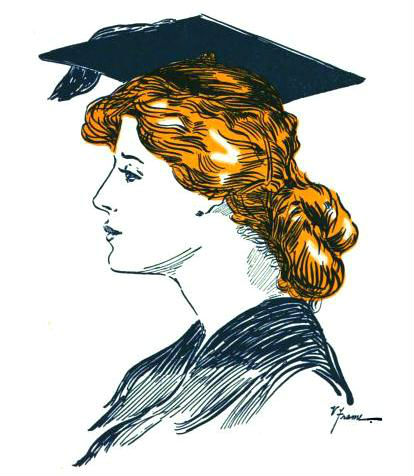Ilustrations from College Girls' Record: A Chronicle of Memories (1910)
Bachelor, spinster, pensioner, penniless artist, yachtsman, marksman, shift worker, stockbroker, picnicker -- each prized his chafing dish.
"Every bachelor has a wife of some sort. Mine is a Chafing Dish; and I desire to sing her praises." -- Frank Schloesser, The Cult of the Chafing Dish (1904)
A forerunner of the fondue pot, the chafing dish, with its small spirit lamp and nickel-plated pans, catered to those whose needs were modest. Though it rendered Lilliputian portions, it could cook anything from deviled lobster and macaroni rarebit to fig cups, peanut drops and wine punch. This versatility made the chafing dish the favorite of lonely hearts, transients and other solitary sorts, who esteemed its ability to elevate dinner from mere utility to true tastiness.
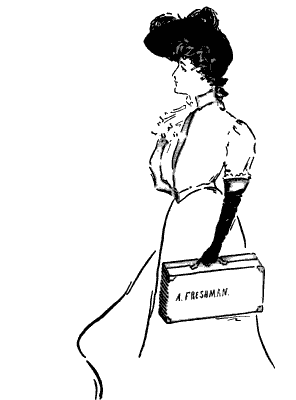
"When the eye of the convalescent brightens and his appetite is stimulated by a choice tidbit prepared on the chafing dish, then its value is most appreciated." -- Fannie Merritt Farmer, Chafing Dish Possibilities (1898)
The chafing dish’s virtues, however, didn’t end with its versatility. Minimizing both waste and expense, it naturally appealed to mid-twentieth century prophets of thrift. Convenient pretty much anytime, the chafing dish on laundry day proved a godsend. Or so thought home economist Sarah Tyson Rorer. Anything that could simplify preparation of the evening meal on such occasions of sudsy drudgery sold itself, she insisted. Among students of The Boston Cooking School, where Yankee reserve bred a taste for modest edibles, the piece of cookware became something of an icon. They could be seen wearing lapel pins that featured its unmistakable silhouette. Around this icon also sprang up a body of literature. Guidebooks bearing such titles as
The Cult of the Chafing Dish and
The Bachelor and the Chafing Dish graced bookstore shelves. Enhancing this cultic appeal was the chafing dish’s ancient origins: The Greeks used it table-side to heat eggs and bits of fruit. Indeed, its aura of classical refinement was such that the plainest gruel simmered in it could conjure images straight from Plato's
Symposium.
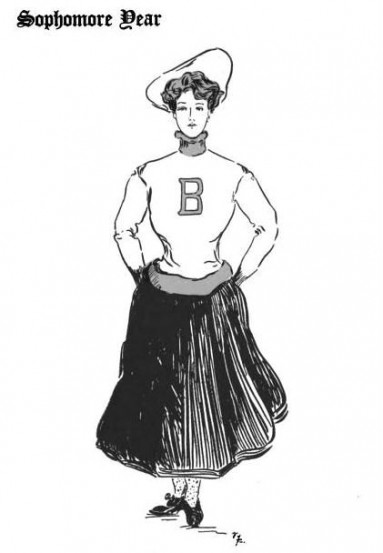
Definition of "Blue-stocking" form Encyclopaedia Americana (1836): "A pedantic female; one who sacrifices the characteristic excellences of her sex to learning.... In Germany, blue-stocking (blau-strumpfe) signifies a traitor, a slanderer, an infamous lover."
Perhaps this association inspired a group of co-eds at a certain unnamed American college to make the chafing dish the crux of a most inventive celebration. They decided to commemorate the final semester of their senior year by hosting a "progressive dinner." To advertise this event, they passed around hand-illustrated menus. The bill of fare reflected the simple party they intended; in place of the gelatin salads and champagne characteristic of swanky hotel buffets appeared homey chafing-dish selections.
"Have you freshmen any long, dreaming twilights? Or have we all grown too busy -- or too frivolous -- to pause "between the dark and the daylight"? -- Helen Dawes Brown, Talks to Freshman Girls (1914)
The dormitory proved as adequate as any ballroom when it came to staging the affair. The young women who occupied the largest rooms served as hostesses. Each hostess had assigned to her one or two "helpers." Each helper stationed herself behind a chafing dish in order to serve the attendees, whose movement from room to room followed the order of courses listed on the menu.
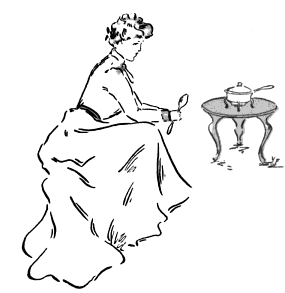
A hostess bearing a small pitcher of cream and a dish of oyster crackers occupied the premiere room. Into a chafing dish of tomato soup she added both ingredients to produce a first course of quiet sophistication.
The hostess of the second room had prepared for her guests a chafing dish of creamed chicken and lettuce sandwiches. Not to be outdone, the third hostess filled her room with plates of salad -- small tidy nests of lettuce into which she piled bananas, oranges, white grapes and apples dressed in mayonnaise and cream. Her guests pronounced them delicious.
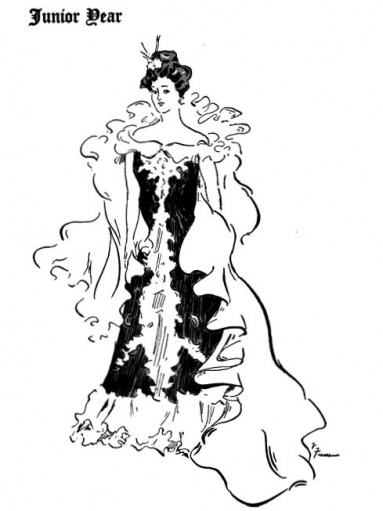
"The only effort of which I know that has been made toward collecting statistic regarding social customs in the co-educational institutions of the United States has been made by the Inter-Sorority Conference Committee appointed in September, 1904.... In this report, the committee states that while changes in social customs must come through changes in public opinion, public opinion is best aroused in the discussion of facts, and it is hoped that the report may at least start discussion and lead to clearer ideas of the best there is, both as to the form and spirit in college social life." -- from the Proceedings of the Annual Session of the Iowa State Education Association (1907)
As much of a splash as the salad in the third room made, the dish awaiting guests in the fourth made an even greater; the hostess therein had whipped up a terrific orange mousse. A resourceful girl, she planned well ahead of the event, blending cream and the juice earlier that afternoon and pouring the mixture into a tin, which she then placed in an ordinary bucket packed with snow scraped from the campus green. She hung the whole thing out her window to freeze in the winter air. The result of her confectionary ingenuity, which she served with wafers, triumphantly capped the meal.
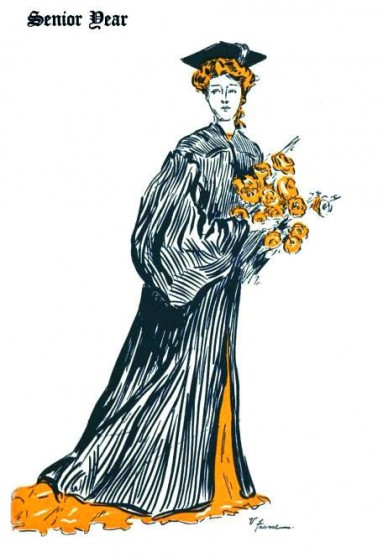
Recipe for Tomato Bisque from Chafing-Dish Dainties (1898): "In the hot water pan heat one pint of tomato liquid, one teaspoon salt, one-half salt-spoon soda, and pepper to taste, adding if desired either Paprika, cayenne, or about two or three drops Tabasco Pepper Sauce. When this is hot remove, and in the blazer over open flame, put one tablespoon butter and one and one-half of flour, blend, and gradually add one pint of milk. When all is blended add the tomato liquid, stirring well and serve hot, with dry toast cut into small bits."
The final room belonged to a hostess who had the good fortune of owning a percolator. Here guests drank coffee and played banjos and sang. High spirits infected all. The party had been the nicest of the year, and had been made all the nicer because the burden of preparation had fallen on no one; and the expense, which had been divided, was less than dinner elsewhere. They agreed that it is far more fun to cook and eat together than to savor a smart dish alone.
